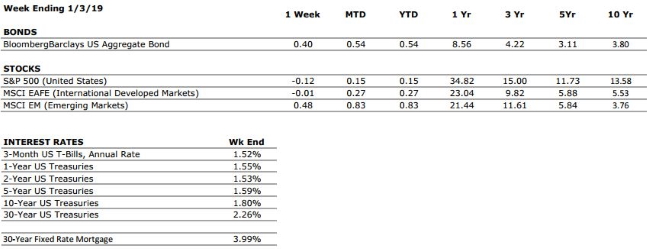
Equities:
Equity markets closed out 2019 with another strong quarter which helped push the S&P 500 to its highest annual return since 2013. Markets continued to achieve new highs throughout most of the year as central bank rate cuts and robust consumer confidence countered the negative effects of trade uncertainty and declining global manufacturing. We often stress to investors that long-term market performance tends to track corporate earnings growth, but over shorter periods of time, it is common to see stock prices and earnings diverge. In our view, this was a key theme of 2019 as stock prices surged higher despite lackluster earnings growth. We can think of stock investing as simply purchasing the right to a share of the future earnings of a company. Thus, stocks have begun to look more “expensive” since investors must now pay a higher price for the same amount of future profits. An acceleration in corporate earnings growth will likely be needed in 2020 in order to sustain and support recent levels of stock market returns. As we move into 2020, consensus analyst estimates are calling for earnings growth just shy of 10%, which would represent a relatively meaningful acceleration from the flat growth we observed in 2019, but a tempering of return expectations going into the new year may be warranted.
Bonds:
The response by central banks around the world to softening economic activity throughout 2019 was also a boon for bond investors. Much of those gains were achieved during the first three quarters however, as optimism surrounding economic growth began to resurface during Q4 leading to a bounce in Treasury rates. Rates across the yield curve are influenced by expectations for economic growth and inflation, and with the unemployment rate at its lowest level since the 1960’s and evidence of wage growth at last emerging, an argument could be made that an uptick in inflation may not be far behind. Depending upon how significant it is, the emergence of inflation would potentially signal the next step in the maturation of the bull market and could push interest rates higher in the coming year.
Outlook:
The healthy returns achieved across most major asset classes made 2019 one of the best years of the current market cycle. Remarkably, it was largely the exact opposite of what occurred during 2018 when most major asset classes exhibited losses. Over the past two calendar years, the benefits of diversification have been harder to see as many assets that historically behaved differently from one another moved in lockstep. This is largely a result of bond yields sitting so close to their lower bounds, and as such, there are potential implications for the expected risk and return profiles of traditional balanced portfolios. If the correlation between stocks and bonds moving forward is higher than it has been in the past, then the diversification benefits of owning bonds will be diminished. This may create challenges for investors, but the good news is that the economy remains healthy and even began to show evidence of firming up during the fourth quarter. If this trend continues, then the probability of recession will decrease in the near-term and the primary risks to the market will remain geopolitical in nature. And as we have stressed in prior commentaries, market declines related to geopolitical events tend to be far shorter and shallower than those that have a more material impact on economic growth.
VIDEO: Q4 2019 Market Commentary
Connor Darrell CFA, Head of Investments, shares Valley National Financial Advisors’ summary of the fourth quarter as we enter 2020. WATCH NOW


